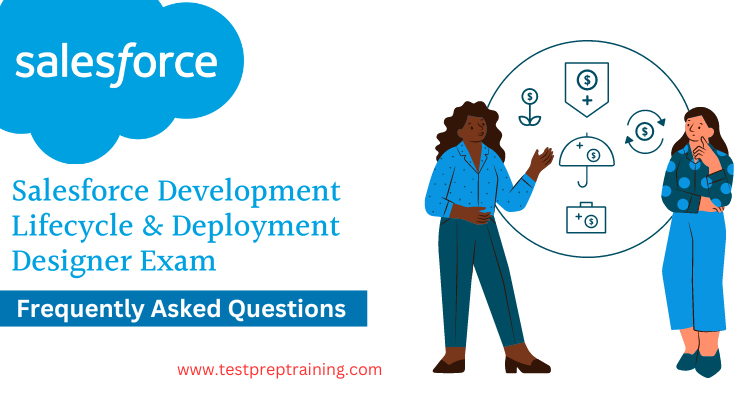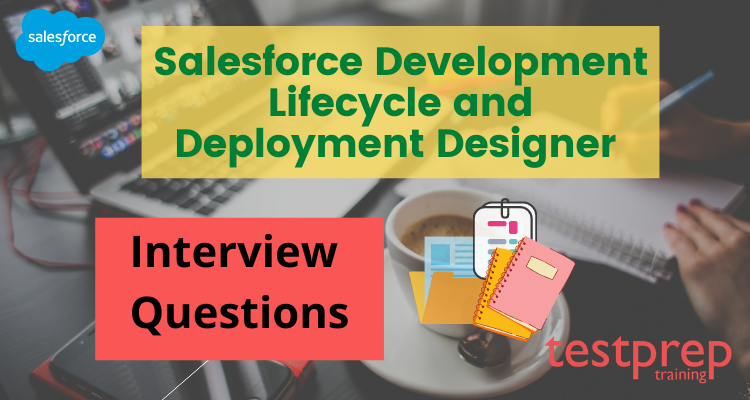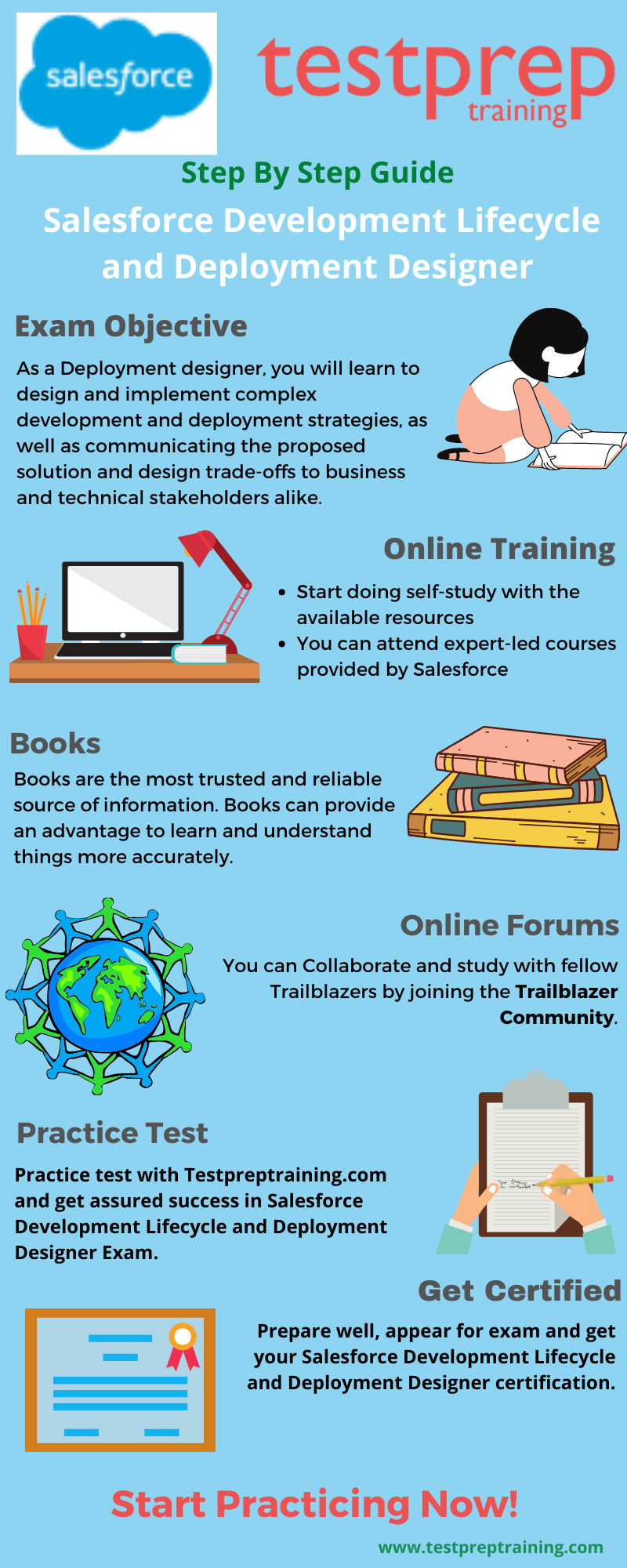Salesforce Development Lifecycle and Deployment Designer

The Salesforce Development Lifecycle And Deployment Designer Certification course focuses on how to manage Lightning Platform development and deployment activities as well as effective communication of technical solutions to business and technical stakeholders. After earning this credential from Salesforce you will experience analyzing the environment and requirements to design an appropriate governance framework. As a Deployment designer, you will also learn to manage the development and deployment lifecycle on the Lightning Platform.
Eligibility Requirement
Eligibility requirements for Salesforce Certified Development Lifecycle and Deployment Designer exam are mentioned below –
- B.S. degree in Computer Science or equivalent degree
- 2 to 3 years of Salesforce Platform experience
- 1 to 2 years of Salesforce experience working or managing Salesforce projects
- 1 to 2 years of experience working on a steering committee
- Completed at least one end-to-end software development lifecycle project
Intended Job Roles
The Salesforce Certified Development Lifecycle And Deployment Designer Jobs are:
- Technical Lead
- Developer Lead
- Project Manager
- Release Manager
- Environment Manager
- Technical Architect
- Developers
- Testers
Exam Details
- Exam Name: Salesforce Development Lifecycle and Deployment Designer
- Number of Questions: 60 multiple-choice/multiple-select questions
- Time: 105 minutes
- Passing score: 68%
- Registration fee: USD 400, plus applicable taxes as required per local law
- Retake fee: USD 200, plus applicable taxes as required per local law
Scheduling the Exam
The Salesforce Development Lifecycle and Deployment Designer exam can be scheduled either at an onsite proctored center or online with a virtual proctor through the salesforce testing partner, Kryterion Global Testing Solutions.

For more details related to exam policies visit: Salesforce Development Lifecycle and Deployment Designer FAQ
Salesforce Development Lifecycle and Deployment Designer Interview Questions
Let us look at some Salesforce Development Lifecycle and Deployment Designer Interview Questions which would help you get an idea as to what questions can be expected in the interview.

Course Outline
The Salesforce Certified Development Lifecycle And Deployment Designer Course is designed in the following manner:
Application Lifecycle Management: 8%
- Given the project risk and customer requirements, explain how to assess the benefits and risks of the different development methodologies and recommend the appropriate governance strategies based on the customer maturity. (Salesforce Documentation: Agile Methodology at Salesforce)
Planning: 13%
- Given a complex customer scenario, assess Application Lifecycle Management maturity and identify the people, technology, and processes required.
- Understand customer environment risks and articulate appropriate mitigation strategies. (Salesforce Documentation:Risk Management)
- Given a customer scenario, analyze and recommend the appropriate governance framework.(Salesforce Documentation: Create a Governance Framework)
- Given a customer scenario involving a new Salesforce release (Summer, Winter, Spring), recommend the appropriate strategy to mitigate risks.
System Design: 15%
- Explain the advantages of using agile tools to support an agile development process. (Salesforce Documentation:Understand Why Salesforce Adopted Agile)
- Given a customer landscape and their requirements, evaluate business, technical and architectural considerations which support the defined org strategy. (Salesforce Documentation:Enterprise Architecture: Single-org versus Multi-org Strategy)
- Given a customer scenario, define an environment (sandbox) strategy that utilizes the correct sandbox types. (e.g. multiple project streams, training requirements, staging, production, and hotfixes) (Salesforce Documentation: Sandboxes: Staging Environments for Customizing and Testing)
- Given a scenario, compare, contrast and recommend the components and tools of a successful deployment strategy. (Salesforce Documentation: Salesforce1 Enterprise Deployment Strategy)
Building: 14%
- Given a customer scenario, explain how source control branching/versioning/merging can be used and recommend appropriate strategies.
- Describe the appropriate approaches to building test data strategy and unit test to ensure successful code (positive, negative, permission-based, large data volume).
- Given a customer scenario, describe the appropriate development model (org-based vs package-based) and development environment (scratch org vs sandboxes).
- Describe the methods to ensure the delivery of quality code, such as coding standards, pull requests, code review, and static code analysis
Deploying: 14%
- Given a scenario, describe the capabilities, limitations and considerations when using the Metadata and Tooling APIs for deployment.
- Given a scenario, describe approaches to handle pre and post deployment steps, including items not supported via the APIs.
- Given a scenario, describe approaches to manage and deploy technical reference data.
Testing: 13%
- Given a customer scenario, describe and recommend an appropriate testing methodology.
- Given a customer testing strategy, describe the appropriate test execution methodology and coverage requirements.
- Given a customer scenario, describe and recommend a unified test data strategy that utilizes representative data in a secure manner throughout the development lifecycle
Releasing: 13%
- Given a scenario, analyze and explain the use cases and considerations when using managed, unmanaged and unlocked packages. (Salesforce Documentation:Understanding Packages)
- Apply map sandbox strategy to a specific Release Plan taking into consideration multiple project streams, training requirements, staging and hotfixes. (Salesforce Documentation: Get to Know the Salesforce Release Process)
- Given a customer scenario, describe and recommend an appropriate release management strategy. (Salesforce Documentation: Develop a Release Management Strategy, Basics of Release Management)
Operating: 10%
- Given a detailed customer environment scenario including a specific request, explain the implications for incorporating the request directly in a production environment. . (Salesforce Documentation: Sandbox Setup Considerations
- Given a customer scenario where changes are made directly in production, explain the implications on the development lifecycle and steps to integrate changes into Application Lifecycle Management.
- Given a multi-org customer scenario, compare and contrast approaches for managing common release artifacts
Preparation Guide
The Preparation Guide is meant to provide you a brief outline of the whole exam pathway. This guide will give you an idea as to how you should get started with the exam preparation. This preparation guide is designed to help you evaluate your readiness to successfully complete the Salesforce Certified Development Lifecycle and Deployment Designer certification exam. So, make sure to take a look at this Salesforce Certified Development Lifecycle And Deployment Designer Guide and kick start your preparation.

Learning Resources
Start your preparation with following set of learning resources:
Salesforce Training
Salesforce provides candidates with training that helps them build confidence and increase their credibility. In the Salesforce Certified Development Lifecycle And Deployment Designer Training, candidates can choose to learn online at their own pace or they can learn from an accredited instructor built by experts at Salesforce. This will be beneficial for both beginners who are building on existing skills, or who are experienced professionals required knowledge. Salesforce offers two types of training that include:
- Start doing self-study with the available resources: Trailmix: Architect Journey: Development Lifecycle and Deployment
- You can attend expert-led courses provided by Salesforce.
Join Community
You can Collaborate and study with fellow Trailblazers by joining the Trailblazer Community. The members of this community are both skilled and experienced developers as well as inexperienced learners. So, joining such a community will resolve most of your exam-related problems. These communities are very interactive and updated with new ideas and new development in the market. Therefore, in order to stay updated and get your queries resolved from experiences members make sure to join this community.
Books
Books are the most trusted and reliable source of information. Books can provide an advantage to learn and understand things more accurately. These books help you get familiar with the Salesforce Development Lifecycle And Deployment Designer Questions. Moreover, there are various books available which you can find online or in libraries.
Exam Practice Tests
Salesforce Certified Development Lifecycle And Deployment Designer Practice Exams are one of the most reliable sources of judging the level of preparation. By practicing you will be able to improve your answering skills in a specified timeframe that will result in saving a lot of time in the actual exam. The practice test will also act as a doubt solver session for you. So, make sure to find the best practice test which suits your requirement and start practicing at the earliest. You can also refer to testpreptraining practice tests, which are based on the actual exam pattern.

